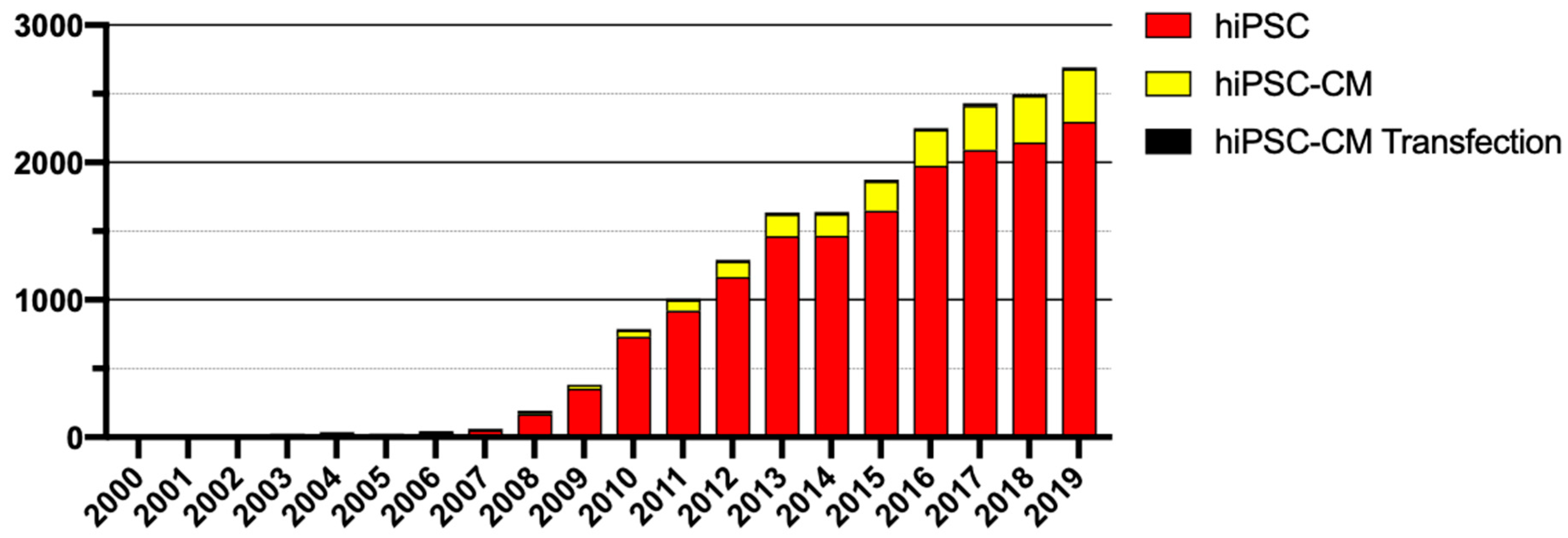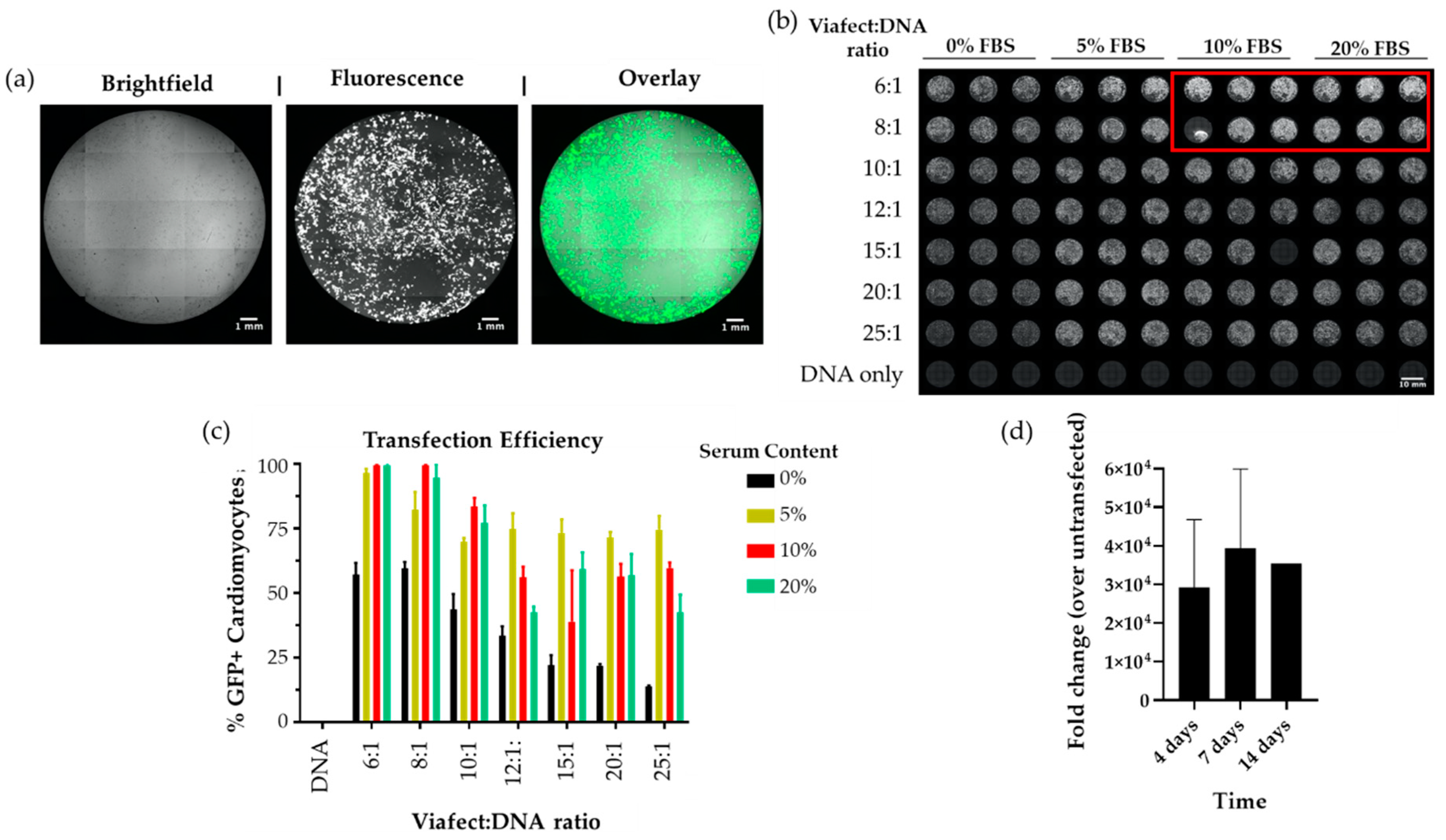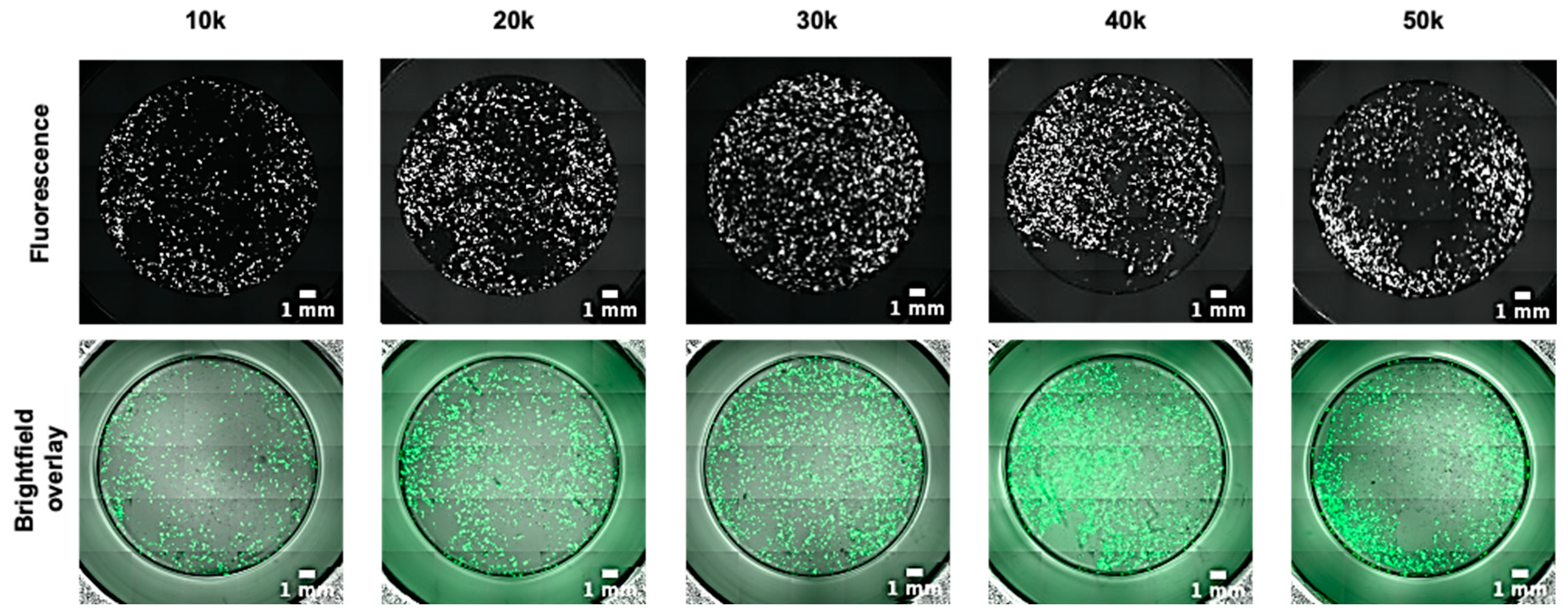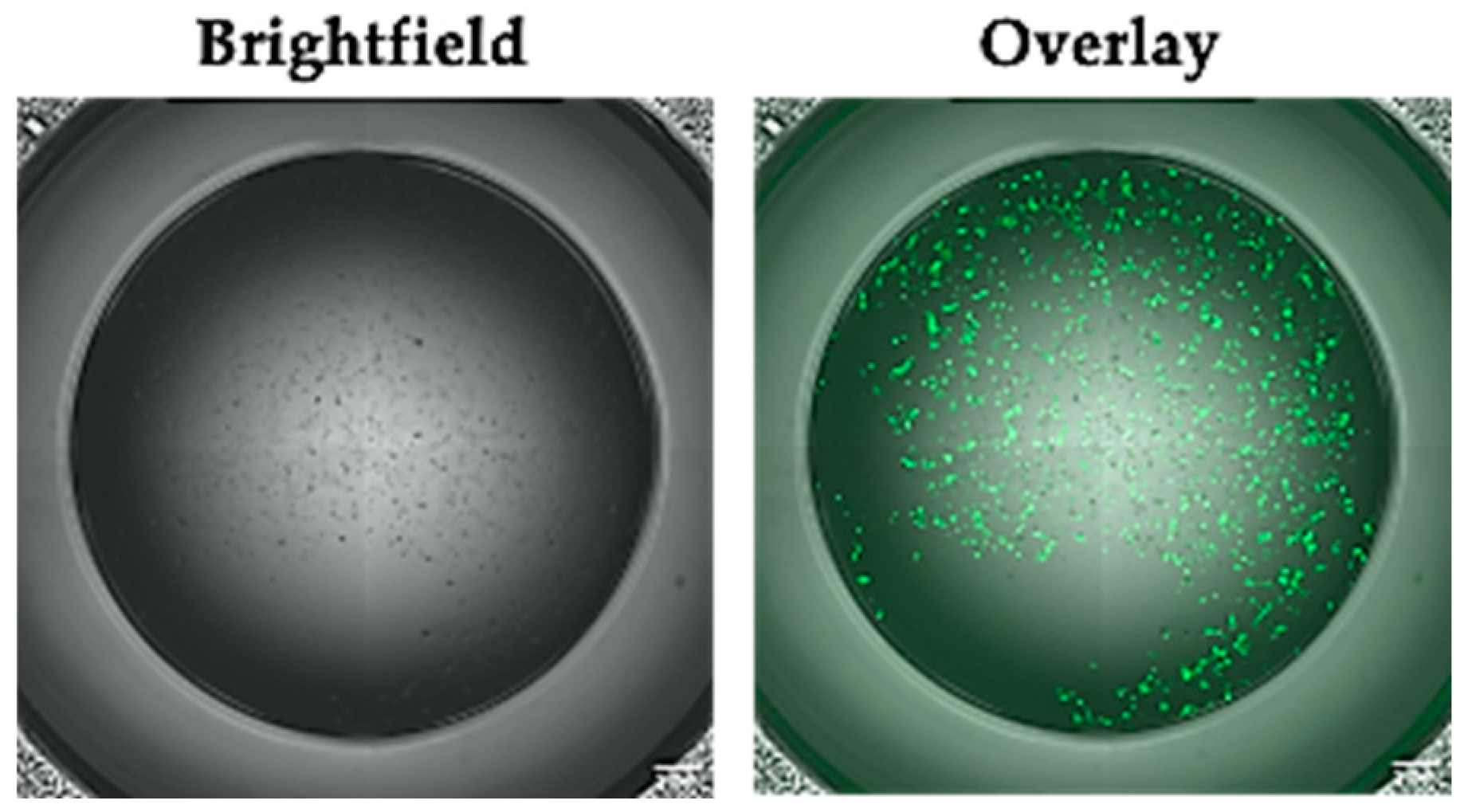Transfection of hPSC-Cardiomyocytes Using Viafect™ Transfection Reagent
Abstract
:1. Introduction
2. Materials and Methods
2.1. Materials
- Vitronectin–Recombinant Human Protein, 500 µg/mL in PBS, (Gibco™, Thermofisher, Loughborough, UK, Cat. No: A174700)
- Phosphate Buffer Saline (PBS, Gibco™, Thermofisher, Loughborough, UK, Cat. No: 14190–094)
- Nunc 96-well Flat Bottom, Delta Coated (Thermofisher, Loughborough, UK, Cat. No: 167008)
- B-27™ Supplement (50X), custom (Gibco™, Thermofisher, Loughborough, UK, Cat. No: 0080085SA)
- RPMI 1640 medium (Gibco™, Thermofisher, Loughborough, UK, Cat. No: 21875034)
- Fetal Bovine Serum (FBS, Gibco™, Thermofisher, Loughborough, UK, Cat. No: 11573397)
- Viafect™ (Promega, Southampton, UK, Cat. No: E4981 1X 0.75 mL, E4982 2X 0.75 mL)
- Opti-MEM™ (Gibco™, Thermofisher, Loughborough, UK, Cat. No: 31985070)
- Axygen™ MaxyClear Snaplock Eppendorff tubes, 1.5 mL (Axygen™, FisherScientific, Loughborough, UK, Cat. No: 11326144)
- Concentrated plasmid DNA of interest (100 ng per well of a 96 well plate is required); if using more than one plasmid divide by the number of plasmids to ensure total of 100 ng per well
- pmaxGFP from Lonza™ P3 Primary Cell 4D-Nucleofector™ X Kit L, (FisherScientific, Loughborough, UK, Cat. No: 11326144), or any other eGFP reporter plasmid high content imaging
- Cellavista® (Synentec, BPES, Kent, UK) or any other fluorescence plate imaging system
2.2. Methods
2.2.1. Replating hPSC-CMs
- Prepare a solution of Vitronectin at 5 µg/mL in PBS (1:100 dilution from stock). A total of 5 mLs is enough to coat a whole 96 well plate.
- Coat a Nunc 96-Well Flat Bottom Delta plate with 50 µL of Vitronectin solution at 5µg/mL. Incubate at room temperature (RT) for 1 h.
- Supplement RPMI 1640 with a B27 supplement (RB27, 1:50 dilution from the stock), aliquot enough for 75 µL/well X the number of wells to be used and let it reach RT.OPTIONAL STEP you may use other culture media and extracellular matrix proteins provided they have been optimised for cardiomyocyte culture.
- Aspirate the Vitronectin and wash with 50 μL PBS. Aspirate PBS and add 75 µL RB27 per well.
- Resuspend pelleted pre-dissociated hPSC-CMs at 1 × 106 cells/mL in RB27, forming a single cell suspension.
- Replate hPSC-CMs at a density ranging from 3.0 × 104 to 4.0 × 104 per well (~95–125 K/cm2) in wells containing 75 μL RB27. Allow the cells to settle for 30 min at RT before placing in the incubator.
- Replace medium with 100 μL/well RB27 every other day for 3 days post plating.
2.2.2. Transfecting hPSC-CMs
- On the morning of transfection, replace media with 90 μL/well RB27 supplemented with 10% FBS.
- Calculate transfection mixture so that each well of a 96 well plate is transfected with 100 ng of plasmid DNA:
- Volume of plasmid(s) =
- Volume of Viafect (μL) (6:1 ratio) =
- Volume of OptiMEM (μL) =
- Before pipetting, allow the reagents to reach RT and mix by inverting.
- On the afternoon of transfection, add the reagent volumes calculated in step 9 to a 1.5 mL Eppendorff tube.
CRITICAL STEP Flick tube to homogenise transfection mixture (do not vortex or pipette mix). Incubate at RT for 20 min.
- Add 10 μL of transfection mixture to each well, directly into the medium without touching the cells.
- Place cells in an incubator at 37 °C and 5% CO2. Replace media the following day with RB27 with or without FBS (as per your standard culture practises) and then every second day from thereon until performing desired phenotypic assay.
- Measure transfection efficiency using an appropriate reporter gene (e.g., GFP), preferably using a high content imaging system.
3. Results
4. Discussion
Supplementary Materials
Author Contributions
Funding
Conflicts of Interest
References
- Ruedel, A.; Bosserhoff, A.K. Methods in Cell Biology; Conn, P.M., Ed.; Academic Press: Cambridge, MA, USA, 2012; Volume 112, p. 544. [Google Scholar]
- Pagano, J.S.; McCutchan, J.H.; Vaheri, A. Factors influencing the enhancement of the infectivity of poliovirus ribonucleic acid by diethylaminoethyl-dextran. J. Virol. 1967, 1, 891–897. [Google Scholar] [CrossRef] [PubMed] [Green Version]
- Kim, T.K.; Eberwine, J.H. Mammalian cell transfection: The present and the future. Anal. Bioanal. Chem. 2010, 397, 3173–3178. [Google Scholar] [CrossRef] [Green Version]
- Recillas-Targa, F. Multiple strategies for gene transfer, expression, knockdown, and chromatin influence in mammalian cell lines and transgenic animals. Mol. Biotechnol. 2006, 34, 337–354. [Google Scholar] [CrossRef]
- Brenet, F.; Moh, M.; Funk, P.; Feierstein, E.; Viale, A.J.; Socci, N.D.; Scandura, J.M. DNA methylation of the first exon is tightly linked to transcriptional silencing. PLoS ONE 2011, 6, e14524. [Google Scholar] [CrossRef]
- Gall, J.G.; Lizonova, A.; EttyReddy, D.; McVey, D.; Zuber, M.; Kovesdi, I.; Aughtman, B.; King, C.R.; Brough, D.E. Rescue and production of vaccine and therapeutic adenovirus vectors expressing inhibitory transgenes. Mol. Biotechnol. 2007, 35, 263–273. [Google Scholar] [CrossRef] [PubMed]
- Mohn, F.; Weber, M.; Rebhan, M.; Roloff, T.C.; Richter, J.; Stadler, M.B.; Bibel, M.; Schubeler, D. Lineage-specific polycomb targets and de novo DNA methylation define restriction and potential of neuronal progenitors. Mol. Cell 2008, 30, 755–766. [Google Scholar] [CrossRef]
- Roth, G.A.; Abate, D.; Abate, K.H.; Abay, S.M.; Abbafati, C.; Abbasi, N.; Abbastabar, H.; Abd-Allah, F.; Abdela, J.; Abdelalim, A.; et al. Global, regional, and national age-sex-specific mortality for 282 causes of death in 195 countries and territories, 1980–2017: A systematic analysis for the Global Burden of Disease Study 2017. Lancet 2018, 392, 1736–1788. [Google Scholar] [CrossRef] [Green Version]
- Mosqueira, D.; Smith, J.G.W.; Bhagwan, J.R.; Denning, C. Modeling Hypertrophic Cardiomyopathy: Mechanistic Insights and Pharmacological Intervention. Trends Mol. Med. 2019, 25, 775–790. [Google Scholar] [CrossRef] [Green Version]
- Chong, J.J.H.; Yang, X.; Don, C.W.; Minami, E.; Liu, Y.-W.; Weyers, J.J.; Mahoney, W.M.; Van Biber, B.; Cook, S.M.; Palpant, N.J.; et al. Human embryonic-stem-cell-derived cardiomyocytes regenerate non-human primate hearts. Nature 2014, 510, 273–277. [Google Scholar] [CrossRef]
- Pagliari, S.; Romanazzo, S.; Mosqueira, D.; Pinto-do-O, P.; Aoyagi, T.; Forte, G. Adult Stem Cells and Biocompatible Scaffolds as Smart Drug Delivery Tools for Cardiac Tissue Repair. Curr. Med. Chem. 2013, 20, 3429–3447. [Google Scholar] [CrossRef]
- Bang, M.L. Animal Models of Congenital Cardiomyopathies Associated With Mutations in Z-Line Proteins. J. Cell Physiol. 2017, 232, 38–52. [Google Scholar] [CrossRef] [PubMed]
- Nerbonne, J.M. Studying cardiac arrhythmias in the mouse—A reasonable model for probing mechanisms? Trends Cardiovasc. Med. 2004, 14, 83–93. [Google Scholar] [CrossRef] [PubMed]
- Ammirati, E.; Contri, R.; Coppini, R.; Cecchi, F.; Frigerio, M.; Olivotto, I. Pharmacological treatment of hypertrophic cardiomyopathy: Current practice and novel perspectives. Eur. J. Heart Fail. 2016, 18, 1106–1118. [Google Scholar] [CrossRef] [PubMed]
- Yu, J.; Yang, Y.; Xu, Z.; Lan, C.; Chen, C.; Li, C.; Chen, Z.; Yu, C.; Xia, X.; Liao, Q.; et al. Long Noncoding RNA Ahit Protects Against Cardiac Hypertrophy Through SUZ12 (Suppressor of Zeste 12 Protein Homolog)-Mediated Downregulation of MEF2A (Myocyte Enhancer Factor 2A). Circ. Heart Fail. 2020, 13, e006525. [Google Scholar] [CrossRef]
- Bhagwan, J.R.; Mosqueira, D.; Chairez-Cantu, K.; Mannhardt, I.; Bodbin, S.E.; Bakar, M.; Smith, J.G.W.; Denning, C. Isogenic models of hypertrophic cardiomyopathy unveil differential phenotypes and mechanism-driven therapeutics. J. Mol. Cell. Cardiol. 2020, 145, 43–53. [Google Scholar] [CrossRef]
- Bhagwan, J.; Collins, E.; Mosqueira, D.; Bakar, M.; Johnson, B.; Thompson, A.; Smith, J.; Denning, C. Variable expression and silencing of CRISPR-Cas9 targeted transgenes identifies the AAVS1 locus as not an entirely safe harbour. F1000Research 2020, 8, 1911. [Google Scholar] [CrossRef]
- Zhang, J.; Ho, J.C.-Y.; Chan, Y.-C.; Lian, Q.; Siu, C.-W.; Tse, H.-F. Overexpression of myocardin induces partial transdifferentiation of human-induced pluripotent stem cell-derived mesenchymal stem cells into cardiomyocytes. Physiol. Rep. 2014, 2, e00237. [Google Scholar] [CrossRef] [Green Version]
- Yamoah, M.A.; Moshref, M.; Sharma, J.; Chen, W.C.; Ledford, H.A.; Lee, J.H.; Chavez, K.S.; Wang, W.; Lopez, J.E.; Lieu, D.K.; et al. Highly efficient transfection of human induced pluripotent stem cells using magnetic nanoparticles. Int. J. Nanomed. 2018, 13, 6073–6078. [Google Scholar] [CrossRef] [Green Version]
- Tan, S.; Tao, Z.; Loo, S.; Su, L.; Chen, X.; Ye, L. Non-viral vector based gene transfection with human induced pluripotent stem cells derived cardiomyocytes. Sci. Rep. 2019, 9, 14404. [Google Scholar] [CrossRef]
- PubMed. Available online: https://pubmed.ncbi.nlm.nih.gov/?term=induced+pluripotent+stem+cells (accessed on 29 May 2020).
- Chatterjee, P.; Cheung, Y.; Liew, C. Transfecting and nucleofecting human induced pluripotent stem cells. J. Vis. Exp. 2011, 56, e3110. [Google Scholar] [CrossRef] [Green Version]
- Haberl, S.; Kanduser, M.; Flisar, K.; Hodzic, D.; Bregar, V.B.; Miklavcic, D.; Escoffre, J.M.; Rols, M.P.; Pavlin, M. Effect of different parameters used for in vitro gene electrotransfer on gene expression efficiency, cell viability and visualization of plasmid DNA at the membrane level. J. Gene Med. 2013, 15, 169–181. [Google Scholar] [CrossRef] [PubMed]
- Hu, Y.C. Baculoviral vectors for gene delivery: A review. Curr. Gene Ther. 2008, 8, 54–65. [Google Scholar] [CrossRef] [PubMed]
- Waehler, R.; Russell, S.J.; Curiel, D.T. Engineering targeted viral vectors for gene therapy. Nat. Rev. Genet. 2007, 8, 573–587. [Google Scholar] [CrossRef] [PubMed]
- Broughton, K.M.; Sussman, M.A. Adult cardiomyocyte cell cycle detour: Off-ramp to quiescent destinations. Trends Endocrinol. Metab. 2019, 30, 557–567. [Google Scholar] [CrossRef]
- Promega. ViaFectTM Transfection Reagent catalog #E4981. Promega Corporation: 2017. Available online: https://www.promega.co.uk/products/luciferase-assays/transfection-reagents/viafect-transfection-reagent/?catNum=E4981 (accessed on 29 May 2020).
- Zhang, J.; Wilson, G.F.; Soerens, A.G.; Koonce, C.H.; Yu, J.; Palecek, S.P.; Thomson, J.A.; Kamp, T.J. Functional cardiomyocytes derived from human induced pluripotent stem cells. Circ. Res. 2009, 104, e30–e41. [Google Scholar] [CrossRef] [Green Version]
- Mosqueira, D.; Mannhardt, I.; Bhagwan, J.R.; Lis-Slimak, K.; Katili, P.; Scott, E.; Hassan, M.; Prondzynski, M.; Harmer, S.C.; Tinker, A.; et al. CRISPR/Cas9 editing in human pluripotent stem cell-cardiomyocytes highlights arrhythmias, hypocontractility, and energy depletion as potential therapeutic targets for hypertrophic cardiomyopathy. Eur. Heart J. 2018, 39, 3879–3892. [Google Scholar] [CrossRef]
- Cowan, C.A.; Klimanskaya, I.; McMahon, J.; Atienza, J.; Witmyer, J.; Zucker, J.P.; Wang, S.; Morton, C.C.; McMahon, A.P.; Powers, D.; et al. Derivation of embryonic stem-cell lines from human blastocysts. N. Engl. J. Med. 2004, 350, 1353–1356. [Google Scholar] [CrossRef] [Green Version]
- Talkhabi, M.; Aghdami, N.; Baharvand, H. Human cardiomyocyte generation from pluripotent stem cells: A state-of-art. Life Sci. 2016, 145, 98–113. [Google Scholar] [CrossRef]
- Mosqueira, D.; Lis-Slimak, K.; Denning, C. High-Throughput Phenotyping Toolkit for Characterizing Cellular Models of Hypertrophic Cardiomyopathy In Vitro. Methods Protoc. 2019, 2, 83. [Google Scholar] [CrossRef] [Green Version]
- Denning, C.; Borgdorff, V.; Crutchley, J.; Firth, K.S.A.; George, V.; Kalra, S.; Kondrashov, A.; Hoang, M.D.; Mosqueira, D.; Patel, A.; et al. Cardiomyocytes from human pluripotent stem cells: From laboratory curiosity to industrial biomedical platform. Biochim. Biophys. Acta Mol. Cell Res. 2016, 1863, 1728–1748. [Google Scholar] [CrossRef]
- Braam, S.R.; Denning, C.; van den Brink, S.; Kats, P.; Hochstenbach, R.; Passier, R.; Mummery, C.L. Improved genetic manipulation of human embryonic stem cells. Nat. Methods 2008, 5, 389–392. [Google Scholar] [CrossRef] [PubMed]
- Rapti, K.; Stillitano, F.; Karakikes, I.; Nonnenmacher, M.; Weber, T.; Hulot, J.S.; Hajjar, R.J. Effectiveness of gene delivery systems for pluripotent and differentiated cells. Mol. Ther. Methods Clin. Dev. 2015, 2, 14067. [Google Scholar] [CrossRef] [PubMed]
- Cervera, L.; Gutierrez-Granados, S.; Martinez, M.; Blanco, J.; Godia, F.; Segura, M.M. Generation of HIV-1 Gag VLPs by transient transfection of HEK 293 suspension cell cultures using an optimized animal-derived component free medium. J. Biotechnol. 2013, 166, 152–165. [Google Scholar] [CrossRef] [PubMed]
- Bergmann, O.; Zdunek, S.; Felker, A.; Salehpour, M.; Alkass, K.; Bernard, S.; Sjostrom, S.L.; Szewczykowska, M.; Jackowska, T.; Dos Remedios, C.; et al. Dynamics of Cell Generation and Turnover in the Human Heart. Cell 2015, 161, 1566–1575. [Google Scholar] [CrossRef]
- Garbern, J.C.; Helman, A.; Sereda, R.; Sarikhani, M.; Ahmed, A.; Escalante, G.O.; Ogurlu, R.; Kim, S.L.; Zimmerman, J.F.; Cho, A.; et al. Inhibition of mTOR Signaling Enhances Maturation of Cardiomyocytes Derived From Human-Induced Pluripotent Stem Cells via p53-Induced Quiescence. Circulation 2020, 141, 285–300. [Google Scholar] [CrossRef]
- Sakuma, T.; Barry, M.A.; Ikeda, Y. Lentiviral vectors: Basic to translational. Biochem. J. 2012, 443, 603–618. [Google Scholar] [CrossRef] [Green Version]
- Dambrot, C.; Braam, S.R.; Tertoolen, L.G.; Birket, M.; Atsma, D.E.; Mummery, C.L. Serum supplemented culture medium masks hypertrophic phenotypes in human pluripotent stem cell derived cardiomyocytes. J. Cell Mol. Med. 2014, 18, 1509–1518. [Google Scholar] [CrossRef]
- Pezzoli, D.; Giupponi, E.; Mantovani, D.; Candiani, G. Size matters for in vitro gene delivery: Investigating the relationships among complexation protocol, transfection medium, size and sedimentation. Sci. Rep. 2017, 7, 44134. [Google Scholar] [CrossRef] [Green Version]
- De Korte, T.; Katili, P.A.; Mohd Yusof, N.A.N.; van Meer, B.J.; Saleem, U.; Burton, F.L.; Smith, G.L.; Clements, P.; Mummery, C.L.; Eschenhagen, T.; et al. Unlocking Personalized Biomedicine and Drug Discovery with Human Induced Pluripotent Stem Cell-Derived Cardiomyocytes: Fit for Purpose or Forever Elusive? Annu. Rev. Pharmacol. Toxicol. 2020, 60, 529–551. [Google Scholar] [CrossRef]




| Condition | Optimal | Range Tested |
|---|---|---|
| Serum content | 10% FBS | 0−20% |
| Day of Transfection after replating | 3 days | 1–7 days |
| Ratio of Viafect™ (μL) to DNA (mass) | 6:1 | 6:1-25:1 |
| Seeding Density per well (96 well plate) | 30–40 K | 10–50 K |
© 2020 by the authors. Licensee MDPI, Basel, Switzerland. This article is an open access article distributed under the terms and conditions of the Creative Commons Attribution (CC BY) license (http://creativecommons.org/licenses/by/4.0/).
Share and Cite
Bodbin, S.E.; Denning, C.; Mosqueira, D. Transfection of hPSC-Cardiomyocytes Using Viafect™ Transfection Reagent. Methods Protoc. 2020, 3, 57. https://doi.org/10.3390/mps3030057
Bodbin SE, Denning C, Mosqueira D. Transfection of hPSC-Cardiomyocytes Using Viafect™ Transfection Reagent. Methods and Protocols. 2020; 3(3):57. https://doi.org/10.3390/mps3030057
Chicago/Turabian StyleBodbin, Sara E., Chris Denning, and Diogo Mosqueira. 2020. "Transfection of hPSC-Cardiomyocytes Using Viafect™ Transfection Reagent" Methods and Protocols 3, no. 3: 57. https://doi.org/10.3390/mps3030057
APA StyleBodbin, S. E., Denning, C., & Mosqueira, D. (2020). Transfection of hPSC-Cardiomyocytes Using Viafect™ Transfection Reagent. Methods and Protocols, 3(3), 57. https://doi.org/10.3390/mps3030057







